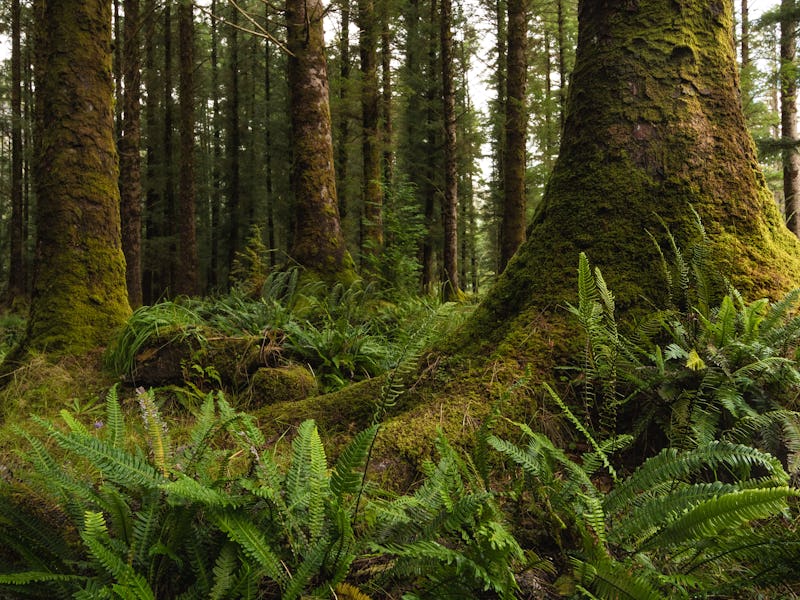Cows Could Hasten the Demise the UK and Ireland’s Secret Rainforests
Only a tiny and fragmented area of the UK and Irish rainforest remains.

A few years back, the president of the National Farmers’ Union of England and Wales wrote a defense of the meat industry after a BBC documentary criticized its environmental impact. “British farmers do not clear rainforest to make way for beef and lamb production,” she wrote. “British meat does not come from the ashes of the Amazon.”
Many believe this, but unfortunately, it isn’t quite true. For one thing, livestock production in the UK and Ireland is still linked to rainforests abroad since chickens, pigs, and cows are often fed imported soybeans. Brazil is the world’s largest soybean exporter, and much of its crop is grown on deforested land.
Many people might also be surprised to learn that Ireland and western regions of Great Britain are home to rainforests: temperate forests, sometimes called Celtic or Atlantic rainforests. And, like their tropical counterparts, UK and Irish rainforests are threatened by grazing livestock, particularly deer and sheep.
Fragmented forests
Only a tiny and fragmented area of the UK and Irish rainforest remains. As the Woodland Trust reports, it “has suffered long-term declines through clearances, chronic overgrazing, and conversion to other uses.”
I’ve found in Twitter discussions that people will argue the treeless state of much of Britain’s National Parks is “natural,” but that’s not the case. When fences are put up, and grazing is excluded, trees and vegetation quickly recover.
To protect nature, we do need to minimize further deforestation. However, we also need to restore what we have lost. We’re used to viewing present-day tree clearing as deforestation, and we now need to view activities that prevent forests from naturally regenerating as deforestation too.
Grazing livestock has huge land footprints
Most of the UK and Ireland’s grass-fed cows and sheep are on land that might otherwise be temperate rainforest — arable crops tend to prefer drier conditions. However, even if there were no livestock grazing in the rainforest zone — and these areas were threatened by other crops instead — livestock would still pose an indirect threat due to their huge land footprint. You need around 35 times more land to get 100 grams of protein from lamb than you do from peas, beans, and other pulses.
Sheep and cows use lots of lands.
Rainforest and livestock grazing are therefore competing for space. The UK and Ireland have some of the lowest forest covers in Europe at 13 percent and 11 percent, respectively, and only one-tenth of this is natural rather than planted. Eating less meat and more plants means your diet has a smaller land footprint, which means more space for woods and rainforests to return.
Yes, grasslands in the British Isles with low levels of grazing can be important ecosystems for wildflowers and insects, but this is not what most grazing land is like. Grassland nature reserves managed for nature and not farming, such as Martin Down in Hampshire, have trees and shrubs — in the spring and summer, the air is filled with birdsong and the ground with butterflies and orchids. They are a far cry from the intensively grazed fields and hillsides, which resemble billiard tables and make up too much of the UK and Ireland’s grasslands.
Martin Down: when grassland is reserved for nature, not livestock.
Eating meat off well-managed nature reserves is arguably fine for nature and climate—– but such tiny amounts are produced from these systems that meat consumption would have to plummet far beyond current reduction targets.
Furthermore, most British grass-fed cows are still fed crops on top of their staple grass. They typically have a larger arable land footprint per 100 grams than British legumes and a massively larger footprint once you factor in their grazing land.
Generally British beef uses more crop land per kilo than British legumes.
There is important on-farm biodiversity that needs to be supported, but this mustn’t be at the expense of conserving and restoring unfarmed ecosystems — which most (but not all) species prefer.
The UK and Ireland are some of the most nature-depleted countries in the world. And grazing is the most common land use — the vast majority of grass-fed livestock are harming, not benefitting, nature.
British and Irish rainforests are moving up the public consciousness thanks to campaigners such as Guy Shrubsole and Eoghan Daltun. People are increasingly aware of the climate impact of meat, but there is still less discussion about its large land footprint and how that harms nature and biodiversity. This will need to change if the world is to achieve recent commitments made at the biodiversity-focused COP15 summit to protect and restore nature.
UK land use and overseas land used to feed the UK. Beef and lamb pasture is the main use in both cases.
This article was originally published on The Conversation by Emma Garnett at the University of Oxford. Read the original article here.
This article was originally published on